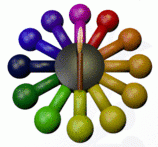How to bend glass tubing and make simple repairs
To break a section of glass tubing: score a line on one side of the tubing. You can use a tungsten blade such as decorators use to scrape wallpaper. Or we have a specific tool here at Flaxmere (metal shelving). Wet a finger with spit and rub against the score, or wet by other means. Bend glass away from your body – it should snap around the score. If there are some sharp shards left on the tubing these can be sandpapered, and the end made softer by heating in a hot Bunsen flame.
Bending tubing for delivery tubes, etc: using a hot Bunsen burner flame, move the tubing in and out of the flame so that a centimetre or two either side of where you want to bend is heated. As you do this apply slight downward pressure on either side of the tubing. After a time, you will feel the glass begin to give. You may now need to take the tubing in and out of the flame to control the degree of bend, and also heat the area around the bend more directly.
NB Borosilicate glass is much tougher and this process is slower. However, if your glass tubing keeps snapping under this pressure, you may have Soda glass. The process needs to be more gentle and slower. Apply less downward pressure and take the tubing out of the flame for longer periods.
Repairs to burettes: score as above where broken section is to be removed. Wet with saliva. Then heat a piece of tubing until very hot (just before melting). Apply on the line scored with a little pressure. The temperature differential should cause the score to crack and the end is able to then be snapped off.
If it doesn’t work first time, you can try again but you may need the burette to cool down again.
NB: if the burette is soda glass then tap slightly above the scored line for a better break
File and heat end of burette to ensure no sharp edges.
Repairs to general glassware: such as chips to beakers, etc. These can just be sanded and heated to smooth over. New pouring lips can be created by heating the rim until glass begins to move, then using a copper tool to push lip in direction required.
Measuring cylinders can have tops removed as per burettes. NB thicker glass is more likely to crack with heat. Broken bases of measuring cylinders can be removed – grind off – and new bases glued with silicon.
